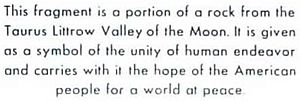West Virginia lunar sample displays facts for kids
The West Virginia Moon Rock Displays are two special plaques. Each plaque holds tiny pieces of real Moon rocks! These rocks were brought back to Earth by astronauts during the Apollo 11 and Apollo 17 missions in the 1970s. The plaques were given to the people of West Virginia by U.S. President Richard Nixon. They were a friendly gift, showing good wishes from the country.
Contents
What Are the Moon Rock Displays?
The Apollo 11 Display
The Apollo 11 Moon rock display for West Virginia is a special plaque. It has four tiny "Moon rocks," about the size of a grain of rice. These rocks were collected by astronauts Neil Armstrong and Buzz Aldrin in 1969. The display also includes a small West Virginia state flag. This flag actually traveled all the way to the Moon and back with the Apollo 11 crew!
The four tiny Moon rocks weigh very little, less than a paperclip. They are safely sealed inside a clear plastic button, like a small coin. This button is attached to a wooden board, which is about one foot square. The board sits on a small stand. Below the Moon rocks, the little West Virginia flag is also attached.
President Richard Nixon gave this display to the people of West Virginia. Other similar Moon rock displays were given to all the other states in the U.S. and to many countries around the world at that time.
The Apollo 17 Display
The Apollo 17 Moon rock display for West Virginia is another special plaque. It is a bit larger, about 10 by 14 inches. This plaque has one small piece of Moon rock. This rock was cut from a larger Moon rock called "lunar basalt 70017." Astronaut Harrison Schmitt collected this rock on the Moon in 1972.
After the basalt rock was brought back to Earth, it was cut into small pieces, each weighing about 1 gram. The piece for West Virginia is sealed inside a clear plastic ball. This ball is attached to a wooden plaque, along with another West Virginia state flag. This flag also traveled to the Moon and back with the Apollo 17 astronauts.
President Richard Nixon gave this plaque to West Virginia in 1973. He also gave similar gifts to the other 49 states. These gifts were meant to promote peace and friendship around the world.
Where Did the Displays Come From?
The Apollo 17 "goodwill Moon rocks" plaque was given to West Virginia in 1973. But after that, it went missing for many years!
In June 2010, a student helped find it. The student was working with Joseph Gutheinz. Mr. Gutheinz used to be a special agent for NASA. He became known for finding missing Moon rock displays. The student tracked the West Virginia Apollo 17 display to the home of a retired dentist in Morgantown, West Virginia.
The dentist, Robert Conner, had inherited many items from his brother's estate in 2002. The NASA Moon rock plaque was one of those items. Mr. Conner thought his late brother, Troy Blaine Conner, Jr., might have received the plaque. His brother was a lawyer who worked with the United States Atomic Energy Commission. Mr. Conner believed the plaque might have come through a connection with former Governor Arch A. Moore, Jr.. He thought Governor Moore might have loaned it to his brother "to observe."
Mr. Conner said the plaque looked so plain that he didn't realize how important it was. He didn't know the state of West Virginia was looking for it. When Mr. Gutheinz contacted him, Mr. Conner understood its value. He hoped that West Virginia University would get it for people to see. He gave it to the West Virginia Division of Culture and History.
The State of West Virginia Division of Culture and History already had the Apollo 11 Moon rock display. As of 2012, the museum now has both the Apollo 11 and Apollo 17 Moon rock displays that were given to the state of West Virginia.




